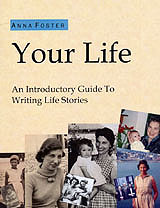
Home > Your Life Writing Guide Contents > Writing Techniques
6. Writing Techniques

In this chapter we will look at some useful writing techniques to enliven your life story.
Speech
You can tell stories using direct speech. It can be used for good dramatic effect, especially to announce imporant news. You can convey excitement, shock or sadness in this way.
Example
In this extract, Joan, the mother, is with her young, sick child in hospital when a doctor arrives unexpectedly, to tell her that her child can neither see nor hear:
There must have been an indication of the pain I felt on my face, because the doctor continued, uninvited, "Don't worry, he won't live".
© Joan Bower
No further explanation is needed to convey the impact of this statement.
Visual Breaks
Break up your text visually. Photographs are often placed in a section in the middle of the book, but digital printing technology allows you to place pictures and other illustrative material wherever you like.
Poems, drawings, newspaper articles, birth announcements, etc. can be positioned next to the relevant section of text.
Make a list of such items at this early stage and pencil a note in the margin where you think they might go. It will help whoever is publishing the book.
Example
When Jane visited Australia on her gap year she listed the many unusual birds she saw in her diary. When she came to produce her book she displayed the birds separately in boxes throughout the text, accompanied by line drawings of these beautiful birds.
Quotes and Extracts
We have talked about using letters and diaries in your book. You can also quote individual lines in the main body of the text.
Example
In his history Winceby House School for Girls, Graham Britnell Green quotes liberally from school magazines, letters between old girls and reminiscences sent to him for the book.
In this extract Kate, an old girl, recalls how the headmistress, known as ‘Madam’, dealt with discipline.
Kate found that Madam’s sense of humour didn’t extend to anything involving rule-breaking. She explains: “I held a party in the bathroom, sailing little boats with paper sails set on fire – pull the plug and see which one gets to the tap end first – a harmless activity I thought, but Madam treated it as an indication of deep moral depravity.”
© Graham Britnell Green
Chapters
It’s up to you if you divide your book into chapters as you go along: some people prefer to write their manuscript as one continuous text. Chapters can be introduced at a later date (even as part of a professional editor’s duties).
Do you have any questions from this section? Please email me and I will try to help you.

